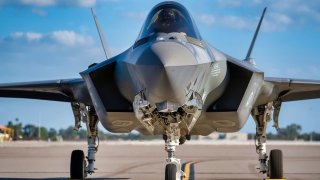The F-35 Stealth Fighter: The Jet Every Air Force Drools Over
The world is starting to become more interested in stealth fighters. Stealth aircraft such as the Su-57, J-20, FC-31, and new models like the Su-75 and NGAD are powerful. But only the F-35 truly delivers.
The world is starting to become more interested in stealth fighters. Stealth aircraft such as the Su-57, J-20, FC-31 and new models like the Su-75 and NGAD are certainly interesting. But only the F-35 truly delivers:
The F-35 Lighting II is touted as one of the most undetectable aircraft to ever take to the skies. The effectiveness of the fifth-generation fighter jet largely hinges on its stealth capabilities.
In an era of advanced air-defense and radar technology, and with near-peer adversaries with advanced military capability, such as China and Russia, every “ounce” of stealth is necessary for the F-35 to survive in a contested air space.
The U.S. Air Force literally paints its fifth-generation aircraft by hand to achieve that.
“Stealthing” the F-35 One Paintbrush At A Time
At 51-feet-long and 35-feet-wide, the F-35 isn’t a small aircraft, especially if you have to hand-paint it with radar-absorbent coating.
Specially trained and qualified Airmen spent hours and hours preparing the classified chemical mix and applying it correctly on the aircraft.
“You can’t just read the steps in the manual. There are requirements for who can do it and inspect it…We take doing it correctly very seriously. We take pride in being experts in our craft because it depends so much on us. There is definitely an art to what we do,” said Master Sergeant John Knowles, the section chief of the 388th Maintenance Squadron, in a press release.
Every F-35 Lighting II comes with a special coat of paint that It is important to note that stealth doesn’t mean invisible. Rather, stealth makes it harder for enemy radar to see and track an aircraft. The aircraft itself is still visible to the naked eye.
“The panels undergo a very in-depth process of different coatings just to remove the latches and cover the fasteners. In the end, there has to be a balance of covering the panel with the proper material while also maintaining full functionality. This is the most frequent job done in the shop, while encompassing the processes of many of their tasks within the unit,” said Staff Sergeant Matthew Hicks, a low observable craftsman 419th Maintenance Squadron.
The special coating, also known as low-observable technology, ensures that an adversary would find it challenging to detect, track or target by radar or missiles the F-35.
“My favorite part of the job is painting because it’s kind of like an art. You get to see it from the beginning and then see it from the end,” said Airman 1st Class Evander Esperanza, a low observable journeyman at the 388th Maintenance Squadron.
But besides looking pleasing to the eye, the coating has to cover every surface, even in spots that don’t see much sunlight, to ensure that equipment doesn’t corrode, causing increased maintenance times or even an accident.
F-35: The Air Force’s Future
The Air Force has based its entire near future on the F-35, so the aircraft has to perform at the expected level and deal with any known, and even unknown, threats. The Pentagon plans to purchase about 2,500 aircraft of all three variants.

“The F-35 Joint Strike Fighter is the cornerstone of our future fighter force and air superiority. Achieving air superiority in a future fight is strongly dependent on full-spectrum dominance. The F-35 and its fifth-generation capabilities are part of our fighter force design that outpaces key competitors,” General CQ Brown, Jr., the Air Force Chief of Staff, has said about the F-35.
About the Author
Stavros Atlamazoglou is a defense journalist specializing in special operations, a Hellenic Army veteran (national service with the 575th Marine Battalion and Army HQ), and a Johns Hopkins University graduate.


